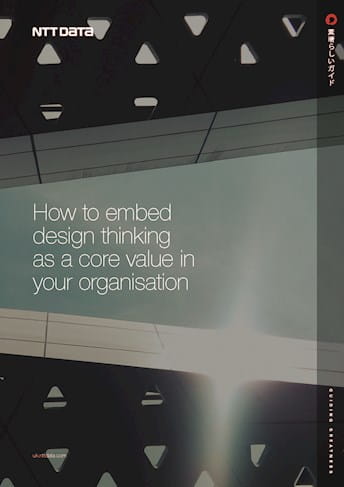Over the last 10 years, much has been written about the power of design thinking to create better customer experiences across different industries and sectors. But there’s another area that has become increasingly important to organisations which remains under-explored: the power of design thinking to re-energise employees.
Today’s (and tomorrow’s) employees use more and more technology to get their work done. Because the quality of the digital experience in their personal lives is now so high, the expectations of the tools and systems they use at work has grown. And, because employees need to solve more problems, with more creativity, than they did 10 years ago, traditional ways of working – with strict processes, long feedback loops and heavy penalties for perceived failures – risk damaging employee productivity.
Design thinking, with its human-centric, solution-based focus on problem framing and solving, can help organisations address this. But applying it on a project-by-project basis isn’t enough. Instead, future-thinking leaders need to empower employees throughout their organisation to address these challenges every day, by giving all of them the skills, approaches and attitudes of design thinkers. To do that, they need to instil design thinking as part of their organisation’s culture – as a core value.
Departments across the organisation will benefit – from HR to IT, from the production line to the CEO. In return, organisations will see sustained improvements in employee engagement and productivity, customer experience metrics and overall organisational performance.
Most people make the mistake of thinking design is what it looks like. People think it’s this veneer — that the designers are handed this box and told, ‘Make it look good!’ That’s not what we think design is. It’s not just what it looks like and feels like. Design is how it works.”
Steve Jobs
Since the turn of the twenty-first century and the growth of online distribution channels, more companies have gained access to more markets around the world, resulting in increased competition. As a result, the price of hardware and components has been driven down, and more and more products now share the same features.
For digital products, functional capability is no longer a competitive advantage. In the mobile phone category, for example, brands like Xiaomi and Oppo sell devices for around £200 that share many of the same specs as those costing three times as much. These companies have captured around 16% of global market share between them in just a few years, basing their business models on minimal labour costs.
Many manufacturers who have survived this intensified competitive environment have seen their margins steadily eroded. But the category leaders, Apple and Samsung, have managed to transcend this base competition by focusing on something beyond functional capability: a superior customer experience, comprising product design, build quality, packaging, after-sales care and the whole brand experience. It’s a key differentiator, as evidenced by the fact that nearly 70% of consumers are happy to pay more for a superior customer experience.
At the same time, while developed economies have grown more service oriented and increasingly digital, organisations have had to adopt a more agile operating model in order to respond to the changing market dynamics. More people are now responsible for decision making across the organisation – and they have higher expectations of their workplace experience as a result.
To deliver on these expectations, organisations can look to the way they have driven competitive advantage with their customers and apply the same thinking to improve their internal processes, systems, tools and working environment.